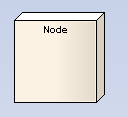
A Node is a physical piece of equipment on which the system is deployed, such as a workgroup server or workstation. A Node usually hosts components and other executable pieces of code, which again can be linked to particular processes or execution spaces. Typical Nodes are client workstations, application servers, mainframes, routers and terminal servers.
Nodes are used in Deployment diagrams to model the deployment of a system, and to illustrate the physical allocation of implemented artifacts.
Toolbox Icon
![]()
OMG UML Specification
The OMG UML specification (UML Superstructure Specification, v2.0, p. 195) states:
"In the metamodel, a Node is a subclass of Class. It is associated with a Deployment of an Artifact. It is also associated with a set of Elements that are deployed on it. This is a derived association in that these PackageableElements are involved in a Manifestation of an Artifact that is deployed on the Node. Nodes may have an internal structure defined in terms of parts and connectors associated with them for advanced modeling applications."
The OMG UML specification (UML Superstructure Specification, v2.0, p. 12) also states:
"A classifier that represents a run-time computational resource, which generally has at least memory and often processing capability. Run-time objects and components may reside on nodes."


